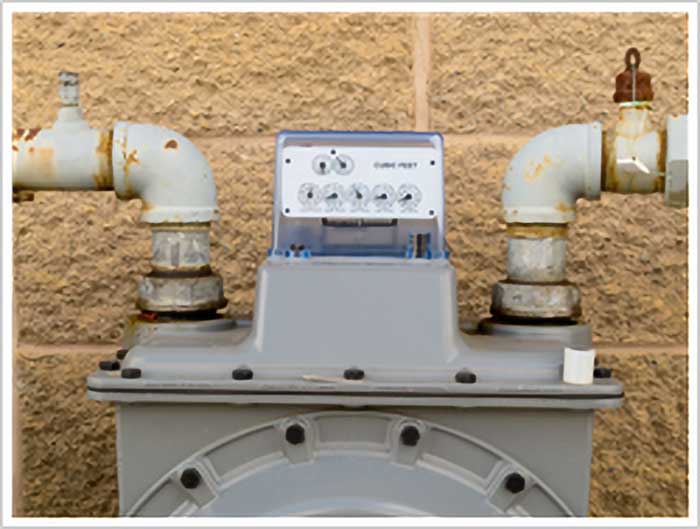WARNING: If you smell gas and are not aware of the location or how to turn off your gas, please immediately get to a safe place and call the gas company or fire department. A natural gas leak is EXTREMELY DANGEROUS and should be approached with the UTMOST CAUTION.
Just as it is important for you to know how to and where the main water shut off valve for the water supply to your house, you also need to be prepared for an emergency by knowing how and where the gas shut off valve is for your home. Keep reading to find out how to detect a gas leak, and how to respond by turning off the gas at your stove, water heater, and gas meter/main gas shut-off valve.
There are many gas appliances options for homes that are run from the home’s gas supply, including hot water heaters, gas fireplace, gas stoves, dryers with a gas system, and of course your HVAC system and furnace. Newer homes and older homes alike can use natural gas and have gas appliances, and the most common way a home’s water heater is operated via natural gas.
First off, do you know the warning signs of a natural gas leak? Like propane, natural gas has a foul odor, and It is not safe to overlook an odor that smells like rotten eggs (this is added to the natural gas supply by your local gas service company, so that in the event of a natural gas leak, homeowners may be alerted via a nasty smell, and if you smell gas you are able to do something about it, such as call the utility company or fire department to alert them after you’ve shut off the gas or got to a safe place.
You may also hear a hissing noise around an appliance that uses natural gas or propane, and if that is the case you will want to immediately shut off the flow of gas to that appliance, or your main gas shut-off valve if necessary. Outside, if you see or feel what looks like air streaming out of the ground, brushing dirt and plants aside like a steady breeze, this could be another signal. Bubbles along damp ground could be another sign, as could wilting, mysteriously dying plants. If you think there could be a gas leak, and you can safely turn off the gas, do so. As soon as you have, or if you cannot get to the shut-off points safely, get to a safe place and call an experienced plumber or the gas company to see if there is a leak. (and remember to have a professional help with the relighting of the pilot lights for any gas appliances when the flow of gas is restored!)
How to Turn Off the Gas to the Stove
First, some words of warning and a tip. You should never employ your stove as a heater; not only is this a fire hazard, but this creates the dire risk of causing carbon monoxide poisoning. Then you can cut down on any fire risks by regularly making sure that grease is not allowed to build up on the stove. When you find a gas leak around the stove, you can:
- Pull it carefully out so you can reach the gas valve. Keep an eye on the gas pipe to make sure that it doesn’t get yanked out when you’re pulling on the stove.
- Turn the gas valve a quarter-inch, to where it will not budge. A gas valve that has been shut off will be horizontal, compared to the vertical gas line.
- Ensure that the gas is indeed off by seeing if the burners on the stove will still turn on.
Still, detect gas? Then this wasn’t the site. You should shut off the gas at the gas meter, if it is safe to do so, then get out to a safe place to call your plumber or a gas company.
How to Shut Off the Gas to the Water Heater
You should not place anything flammable close to your water heater, and you really should not keep anything around your heater. This is not a good spot for storage. A lack of ventilation is a fire risk. It will also free up your path to vital elements, such as the gas valve. To switch the gas off:
- Find the gas pipe leading into the heater, and turn the valve a quarter-turn, after which point you shouldn’t be able to twist it any further. The turned-off valve and gas line will form a plus sign.
- Double check that the heater is, in fact, off, OR,
- If you still sense a gas leak, turn off the gas at the meter, if you can, and then call your gas company.
How to Shut Off the Gas Meter
You need to know ahead of time where your natural gas meter is and the service shutoff valve so that you can find it right away in an emergency. This will be somewhere outside your home. Typically it will be a street-side valve, or the side of the house facing the street. There will be a black iron pipe jutting out of the ground that feeds into the meter. On the pipe, there will be a shut off valve, probably 6 inches off the ground. When the valve is on, it will be lined up with the pipe. To turn it off:
- You need a gas shut-off tool (think pipe wrench or crescent wrench or adjustable wrench).
- Use the tool to twist the ball valve by a quarter-inch either way so that it lines up crossways to the gas line.
Even though the gas is now off, you still need to find a safe distance from which you can call the gas company or a plumber to help you detect the leak and figure out the repairs that need to be made.
Call Our Kansas Plumber for the Same Day Emergency Service You Need
If you are faced with a gas leak, burst pipe, or some other plumbing emergency, you can rely on A-1 Sewer & Septic Service, Inc. Not only do our plumbing experts have more than 45 years of experience in the business, we also offer emergency services on the weekend or in the evening. Find out how our team of Kansas City plumbers can provide the efficient, high-quality service you deserve when you call us now to get your quote!


